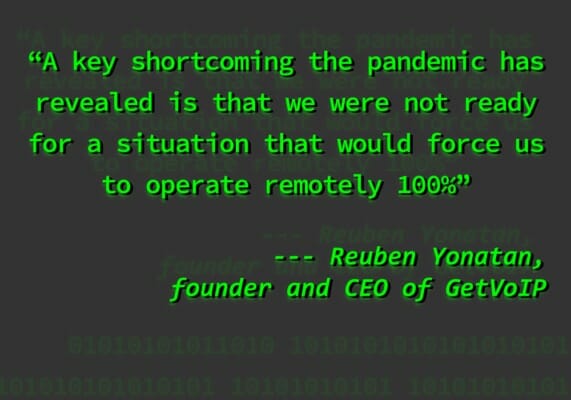What has leadership learned from COVID-19?

While no company welcomes an event such as the COVID-19 pandemic, such a challenge can prove a valuable learning experience. Here, leaders from various industries share discoveries they made during the crisis and how this new knowledge will shape their business’s future.
The need for better preparation
Whether realizing half your team has never been shown how to connect to a specific communications tool or figuring out that cybersecurity enters a new level of concern when work takes place outside of office doors, employers routinely report the last few weeks as a wake-up call regarding emergency preparedness.
“A key shortcoming the pandemic has revealed is that we were not ready for a situation that would force us to operate remotely 100%,” says Reuben Yonatan, founder and CEO of GetVoIP. “Sure, we pivoted quickly, but we still had some issues regarding how to collaborate efficiently and how to ensure the communication between team members was effective. Going forward, we will come up with an exhaustive WFH (work from home) policy.”
Echoing this sentiment, Liam Flynn, founder and editor of Music Grotto, states, “It’s impossible to prepare for every eventuality, and we couldn’t have predicted this, but for the future we plan to get everything set up so that we can immediately adapt to anything. Our work from home policies will be improved, we will make sure everyone is on board with storing everything in the Cloud, and we will make full use of project management tools and communication channels to make sure that we are ready for anything that may come our way.”
New appreciation for remote work
Many employers have been offering telecommuting opportunities for years. Others never considered such arrangements possible for their company—until now.
David Vranicar, managing partner and founder of FBS Fortified & Ballistic Security, is one such convert. “Living through the pandemic taught FBS about our ability to work remotely,” he says. “Before the lockdown, working remotely wasn’t even considered. Once our hand was forced and we began working from home, it became apparent that it was something our company could do and even thrive doing. It has expanded our hiring pool and allowed us to create positions that weren’t feasible in the past.”
Dušan Goljic´, co-founder of DealsOnHealth, has been so impressed with the results of employees working from home that his company is “seriously rethinking coming back to the office” or at least adopting some new procedures.
“We’ve noticed that productivity levels improved on average by 25% since we started working remotely,” Goljic´ says. “We believe this happened due to the lack of distractions employees are exposed to in the office. Furthermore, they tend to be less tired as well because they don’t spend time commuting.”
To make sure everything got done on time while working remotely, the company decided to track tasks in Asana and have team meetings once a week. “It turns out that we gave more structure to the employees in the crisis situation than when things were ‘normal,’” he says. “If we don’t switch to remote, we will undoubtedly continue to assist our employees much better than we were before. Task tracking will definitely stick, and weekly meetings will become routine once we return to the office.”
Study: Coronavirus has altered work for 74% of employers
Planning is well underway for U.S. employers to get back to work in a post-covid-19 environment, according to a new survey by the Willis Towers Watson consulting firm. Among the key adjustments: When operations “get back to normal,” three times more full-time employees will be working remotely, compared to before the pandemic hit.
The survey of 681 employers, conducted during the week of May 11, found that 74% of employers had altered their operations in some way to reflect new post-pandemic protocols. Examples: Installing touchless payment systems, offering services via video rather than in person, creating more space on assembly lines or in distribution centers and changing work schedules to limit employee contact.
Almost three in 10 respondents (29%) had reassigned some job responsibilities, while 23% made changes to reflect work that was being done in-house instead of by third parties. Some employers started outsourcing work or using gig talent for work that was typically done by full-time employees.
Just over half (53%) of full-time employees currently work remotely or from home. While that is expected to drop to 22% after the pandemic passes, it would still be up significantly from last year’s 7%. Conversely, employers expect two-thirds of their workforce to be full-time employees working in person or onsite post-covid-19, up from 37% currently, but still below last year’s 82%.
There’s always room for improvement
Even companies accustomed to virtual operations learned a thing or two while facing new challenges over the past several weeks.
“The one thing that the coronavirus pandemic taught us is that just because we work remotely, we haven’t fully cracked the code of being 100% productive,” says Malte Scholz, CEO and co-founder of Airfocus. “When the pandemic started, we were all working from home, just as usual, but there was one major difference. Our entire families were now home, too, because they were on hold at work and our children were not at school. None of us could do a standard 9-5 work day, no matter how hard we tried.”
Airfocus decided to experiment with flexible working hours to better integrate professional and personal obligations. Staff could work any time they wanted, as long as they were available for calls from 3-5 p.m. Productivity soared, and Scholz says the company will stick to this schedule even after the pandemic is gone.
So, while 2020 may be remembered as a year that changed the concept of “business as usual,” at least some of those alterations seem destined to be positive.







